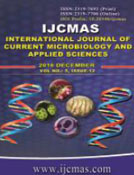


 National Academy of Agricultural Sciences (NAAS)
National Academy of Agricultural Sciences (NAAS)

|
PRINT ISSN : 2319-7692
Online ISSN : 2319-7706 Issues : 12 per year Publisher : Excellent Publishers Email : editorijcmas@gmail.com / submit@ijcmas.com Editor-in-chief: Dr.M.Prakash Index Copernicus ICV 2018: 95.39 NAAS RATING 2020: 5.38 |
Ventilator associated pneumonia (VAP) affects approximately 30% of intubated mechanically ventilated patients in intensive care units (ICUs) worldwide. Acinetobacter baumannii causing VAP is often resistant to a wide variety of antibiotics including carbapenems that have been considered the drug of choice for the treatment for this infection. To characterize A. baumannii as a cause of VAP in our ICUs and to study its incidence, antimicrobial resistant profile and to investigate the presence of carbapenem hydrolyzing class D b-lactamase genes as a cause of carbapenem resistance among the studied isolates. A total of 44 A. baumannii isolates were recovered from 135 endotracheal aspirate samples of VAP patients. A. baumannii were identified by Matrix-assisted laser desorption ionization–time of flight mass spectrometry and its antimicrobial susceptibility was investigated by VITEK 2 instrument and E test, class D b- lactamase genes were investigated by multiplex PCR technique. All A. baumannii isolates were multidrug resistant;75% were resistant to carbapenems while colistin remains the most active compound among the studied isolates with sensitivity rate of 93.2%. Multiplex PCR results showed that allA. Baumannii isolates were positive for blaOXA-51- like gene while 69.7% of carbapenems resistant isolates were positive for blaOXA-23 like gene,blaOXA-58 and blaOXA-24 like genes were not detected in any of the studied isolates. This study highlights the emergence of carbapenem resistant A. baumannii as a cause of VAP in our ICUs that was mostly due the presence of blaOXA-23 like gene.
 |
 |
 |
 |
 |